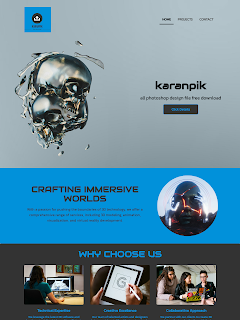website design | web | design |
Website design refers to the process of creating the visual and functional aspects of a website, focusing on both its layout and user experience (UX). It combines elements of graphic design, interaction design, and web development to produce a website that is not only aesthetically pleasing but also effective and easy to navigate. Below is a description of the key components involved in website design:
1. Layout and Structure
Grid System: The foundation of most web designs, providing a framework for placing content, images, and other elements in a structured manner.
Navigation: A crucial part of the design, ensuring users can easily find information. It includes menus, breadcrumbs, and links that guide users through the site.
Responsive Design: Ensures the website is fully functional and looks good on various screen sizes, from desktops to smartphones.
2. Visual Design
Color Scheme: The selection of colors used in the design, which should align with the brand identity and create visual harmony.
Typography: The choice of fonts, sizes, and spacing to enhance readability and the overall look of the site.
Imagery and Icons: High-quality images, illustrations, and icons that complement the content and contribute to the user experience.
3. User Experience (UX) Design
User-Centered Design: Focuses on making the website easy to use, intuitive, and enjoyable for visitors, taking into account user behavior and preferences.
Speed and Performance: Ensures that the website loads quickly and performs well across devices.
Accessibility: Making sure the site is usable by people with disabilities, including options for screen readers, keyboard navigation, and color contrast.
4. Functionality
Interactive Elements: Features like forms, buttons, sliders, and other interactive elements that enable users to engage with the website.
Content Management System (CMS): A backend system that allows easy updates and management of the website's content without requiring technical skills.
SEO Optimization: Structuring the site and its content in a way that helps it rank better in search engines, improving visibility.
5. Branding
Consistency: The website's design should align with the brand's identity, ensuring consistent use of logos, colors, and tone of voice.
Trust Signals: Design elements that build credibility, such as testimonials, certifications, and security icons.
6. Mobile First Design
Prioritizing Mobile Devices: With a large portion of internet traffic coming from mobile devices, designing for mobile first is key. This involves optimizing layouts, navigation, and content for smaller screens before scaling up for larger devices.
7. Prototyping and Wireframing
Wireframes: Simple, low-fidelity layouts that outline the basic structure of the site, including placement of text, images, and navigation elements.
Prototypes: Higher-fidelity mockups that give a more realistic view of the final product, helping stakeholders visualize the user flow and design elements.
8. Testing and Feedback
User Testing: Gathering feedback from real users to identify pain points and areas for improvement.
Cross-Browser Testing: Ensuring the website works properly across all major browsers (Chrome, Firefox, Safari, etc.).
A/B Testing: Experimenting with different designs or features to see which one performs better in terms of user engagement and conversions.
9. Maintenance and Updates
Ongoing Maintenance: Regular updates to ensure the website stays current, functional, and secure. This may include software updates, security patches, and content updates.Analytics: Integrating tools like Google Analytics to monitor user behavior and make data-driven decisions about design improvements.
In essence, website design is a balance between aesthetics and usability, aiming to create an engaging, functional, and visually appealing experience for users while aligning with business objectives.








0 Comments
thank you for watching